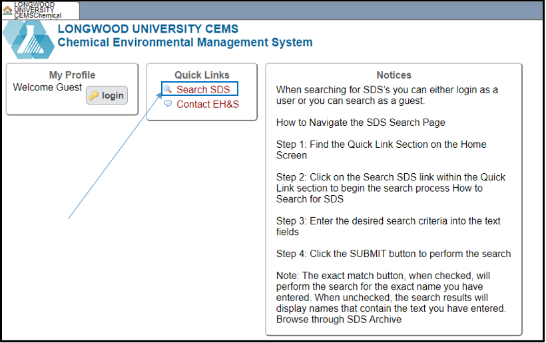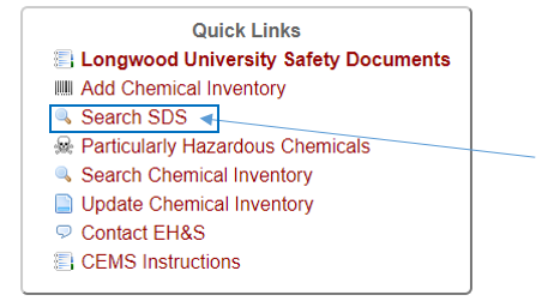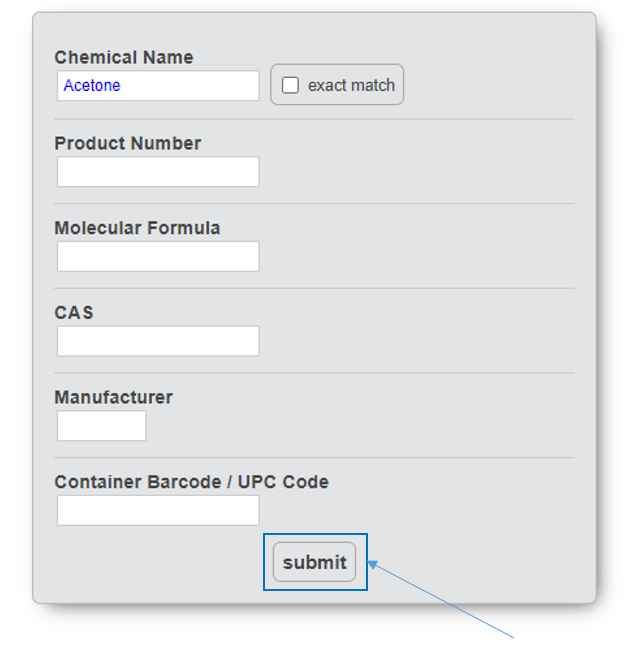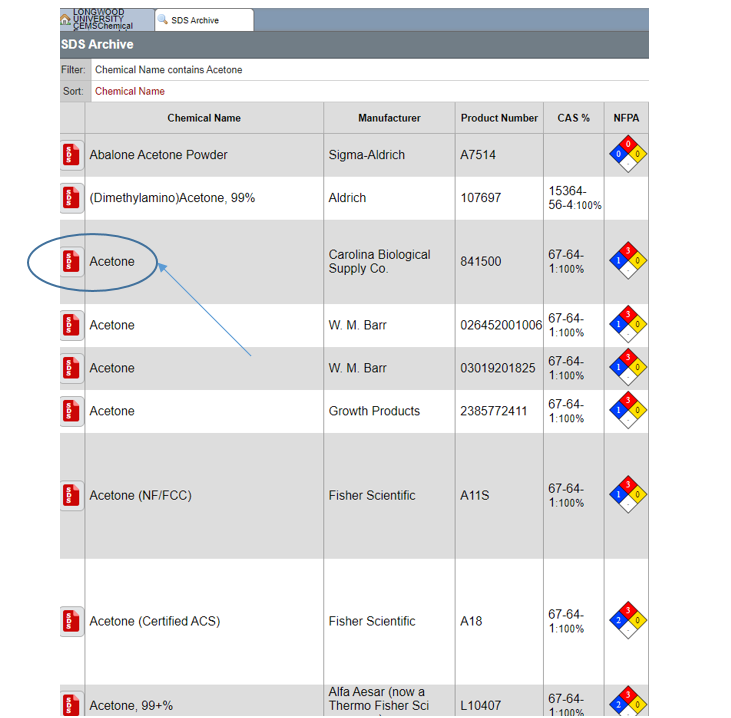Safety Data Sheets
The primary hazard communication tools in the US are container labels and safety data sheets (SDS). Both documents use standardized pictograms and phrases to communicate the hazards presented by commercial chemical products.
Longwood University provides SDSs to employees and students from any Longwood networked computer. Staff and Faculty at risk of exposure are encouraged to bookmark this site on their device.
 If you wish to access SDS's from your mobile device, use this QR code to bookmark the site. NOTE: Your device must be on Lancernet for this link to work.
If you wish to access SDS's from your mobile device, use this QR code to bookmark the site. NOTE: Your device must be on Lancernet for this link to work.
Longwood University Chemical Environmental System
NOTE: This application doesn’t work well with Internet Explorer. Firefox and Chrome seem to work well with this service.
When searching for SDS’s you can either login as a user or you can search as a guest.
|
How to Navigate the SDS Search Page |
Searching as a guest:

Searching by logging in:

Step 1: Find the Quick Link Section on the Home Screen
Step 2: Click on the Search SDS link within the Quick Link section to begin the search process
|
How to Search for SDS |

Step 1: Enter the desired search criteria into the text fields
Step 2: Click the SUBMIT button to perform the search
Note: The exact match button, when checked, will perform the search for the exact name you have entered. When unchecked, the search results will display names that contain the text you have entered.
|
Browse through SDS Archive |

Hard copies of SDSs should be on-hand for commonly used hazardous materials.
For an explanation of the Hazard Pictograms used on the SDS or the product label go to NIH Hazard Pictograms
The SDS must also be written in English and, at a minimum, must contain the following:
SECTION 1: IDENTIFICATION
Section 1 identifies the chemicals on the SDS and recommended uses. It also provides contact information for the supplier. Information required in this section includes:
- The product identifier used on the label and any common names or synonyms which the substance is known.
- Name, address, phone number of manufacturer, importer, or other responsible party, and emergency phone number.
- Recommended use of the chemical (such as a brief description of what it does) and any restrictions on use.
SECTION 2: HAZARD IDENTIFICATION
Section 2 identifies the hazards of the chemical and the appropriate warning information associated with the hazards. Information required in this section includes:
- The hazard classification of the chemical.
- Signal word.
- Hazard statement(s).
- Pictograms
- Precautionary statement(s).
- Description of any hazard not otherwise classified.
- For a mixture that contains an ingredient(s) with unknown toxicity, a statement describing how much (percentage) of the mixture consists of ingredient(s) with unknown toxicity. Note that this is a total percentage of the mixture and not tied to the individual ingredient(s).
SECTION 3: COMPOSITION/INFORMATION ON INGREDIENTS
Section 3 identifies the ingredient(s) contained in the product identified on the SDS including impurities and stabilizers. This section includes information on substances, mixtures, and all chemicals where a trade secret is claimed. Information required in this section includes:
Substances
- Chemical name.
- Common name and/or synonyms.
- Chemical Abstract Service (CAS) number and other unique identifiers.
- Impurities and stabilizing additives, which are themselves classified and which contribute to the classification of the chemical.
Mixtures
- Same information as required for substances.
- The chemical name and concentration (i.e., exact percentage) of all ingredients which are classified as health hazards and are:
- Present above their cut-off/concentration limit, or
- Present a health risk below the cut-off/concentration limit.
- The concentration (exact percentages) of each ingredient must be specified except concentration ranges may be used I the following situations:
- A trade secret,
- There is batch-to-batch variation, or
- The SDS is used for a group of substantially similar mixtures.
Chemicals where a trade secret is claimed
A statement that the specific chemical identity and/or exact percentage (concentration) of composition has been withheld as a trade secret is required.
SECTION 4: FIRST AID MEASURES
Section 4 describes initial care that should be provided by untrained responders to an individual who has been exposed to the chemical. Information required in this section includes:
- Necessary first-aid instructions by relevant routes of exposure (inhalation, skin and eye contact, and ingestion).
- Description of the most important symptoms or effects, and any symptoms that are acute or delayed.
- Recommendations for immediate medical care and special treatment needs when necessary.
SECTION 5: FIRE-FIGHTING MEASURES
Section 5 provides recommendations for fighting a fire caused by the chemical. Information required in this section includes:
- Recommendations of suitable extinguishing equipment, and information about extinguishing equipment that is not appropriate for a particular situation.
- Advice on specific hazards that develop from the chemical during a fire, such as any hazardous byproducts created when the chemical burns.
- Recommendations of special protective equipment or precautions for firefighters.
SECTION 6: ACCIDENTAL RELEASE MEASURES
Section 6 provides recommendations on the appropriate response to spills, leaks, or releases, including containment and clean up practices to prevent or minimize exposure to people, properties, and/or the environment. It may also include recommendations distinguishing between responses for large and small spills where the spill volume has a significant impact on the hazard. Information required in this section includes:
- Use of personal precautions (such as removal of ignition sources or providing sufficient ventilation) and protective equipment to prevent contamination of skin, eyes, and/or clothing.
- Emergency procedures, including instructions for evacuations, consulting experts when needed, and appropriate protective clothing.
- Methods and materials used for containment (e.g., cover drains and capping procedures).
SECTION 7: HANDLING AND STORAGE
Section 7 provides guidance on safe handling practices and conditions for safe storage. Information required in this section includes:
- Precautions for safe handling, including recommendations for handling incompatible chemicals, minimizing release into the environment, and providing advice on general hygiene practices (e.g., eating, drinking, and smoking in work areas prohibited).
- Recommendations on the conditions for safe storage, including any incompatibilities. Provide advice on specific storage requirements (e.g., ventilation).
- Clean up procedures (e.g., appropriate neutralization techniques, decontamination, cleaning or vacuuming, adsorbent materials, and/or equipment required for containment/clean up).
SECTION 8: EXPOSURE CONTROLS/PERSONAL PROTECTION
Section 8 indicates the exposure limits, engineering controls, and personal protective measures that can be used to minimize exposures. Information required in this section includes:
- OSHA Permissible Exposure Limits (PELs), American Conference of Governmental Industrial Hygienists (ACGIH) Threshold Limit Values (TLVs), and any other exposure limit used or recommended by the manufacturer, importer, or employer preparing the SDS.
- Appropriate engineering controls (i.e., use local exhaust ventilation, or use only in a closed system).
- Recommendations for personal protective measures to prevent illness or injury from exposure, such as personal protective equipment (PPE) (e.g., eye, face, skin, or respiratory protection needed).
- Any such special requirements for PPE, protective clothing or respiratory protection (e.g., type of glove material and breakthrough time of the glove material).
SECTION 9: PHYSICAL AND CHEMICAL PROPERTIES
Section 9 identifies physical and chemical properties associated with the substance or mixture. The minimum required information required in this section includes:
- Appearance (physical state, color, etc.)
- Odor
- Odor threshold
- pH
- Melting/freezing point
- Initial boiling point and boiling range
- Flash point
- Evaporation Rate
- Flammability (solid, gas)
- Upper/lower flammability/explosive limits
- Vapor pressure
- Vapor density
- Relative density
- Solubility
- Partition coefficient
- Auto-ignition temperature
- Decomposition temperature
- Viscosity
The SDS may not contain every item on the above list as information may not be relevant or is not available. When this occurs, a notation to that effect must be made for that chemical property. Manufacturers may also add other related properties such as the dust deflagration index (Kst) for combustible dusts, used to evaluate a dust’s explosive potential.
SECTION 10: STABILITY AND REACTIVITY
Section 10 describes the reactivity hazards of the chemical and chemical stability. This section is divided into three sections; reactivity, chemical stability, and other. Information required in this section includes:
Reactivity
- Description of the specific test data for the chemical(s). This data can be for a class or family of the chemical if the data adequately represents the anticipated hazard of the chemical(s), where available.
- Indication of whether the chemical is stable or unstable under normal ambient temperature and conditions while in storage and being handled.
- Description of any stabilizers that may be needed to maintain chemical stability.
- Indication of any safety issues that may arise should the product change in physical appearance.
Chemical Stability
Other
- Indication of the possibility of hazardous reactions, including a statement whether the chemical will react of polymerize, which could release excess pressure of heat, or create other hazardous conditions. Also, a description of the conditions under which a hazardous reaction may occur.
- List of all conditions that should be avoided (e.g., static discharge, shock, vibrations, or environmental conditions that may lead to hazardous conditions).
- List of all classes of incompatible materials (e.g., classes of chemicals or specific substances) with which the chemical could react to produce a hazardous situation.
- List of any known or anticipated hazardous decomposition products that could be produced because of use, storage, or heating. (Hazardous decomposition products should also be included in Section 5, Fire-Fighting Measures.
SECTION 11: TOXICOLOGICAL INFORMATION
Section 11 provides toxicological and health effects information or indicates that such data are not available. Information required in this section includes:
- Information on the likely routes of exposure (inhalation, ingestion, skin and eye contact). The SDS should also indicate if the information is unknown.
- Description of the delayed, immediate, or chronic effects from short- and long-term exposures.
- The numerical measures of toxicity (e.g., acute toxicity estimates such as the LD50 (medial lethal dose))-the estimated amount [of a substance] expected to kill 50% of test animals in a single dose.
- Description of the symptoms. This description includes the symptoms associated with exposure to the chemical including symptoms for the lowest to the most severe exposures.
- Indication of whether is listed in the National Toxicity Program (NTP) Report on Carcinogens (latest edition) or has been found to be a potential carcinogen in the International Agency for Research on Cancer (IARC) Monographs (latest edition) or found to be a potential carcinogen by OSHA.
SECTION 12: ECOLOGICAL INFORMATION (NON-MANDITORY)
Section 12 provides information to evaluate the environmental impact of the chemical(s) if it were released to the environment. Information in this section may include:
- Data from toxicity tests performed on aquatic and/or terrestrial organisms, where available (e.g., acute or chronic aquatic toxicity data for fish, algae, crustaceans, and other plants; toxicity data on birds, bees, plants).
- Whether there is a potential for the chemical to persist and degrade in the environment either through biodegradation or other processes, such as oxidation or hydrolysis.
- Results of tests of bioaccumulation potential, making reference to the octanol-water partition coefficient (KOW) and the bio-concentration factor (BCF) where available.
- The potential for a substance to move from the soil to the groundwater (indicate results from adsorption studies of leaching studies).
- Other adverse effects (e.g., environmental fate, ozone layer depletion potential, photochemical ozone creation potential, endocrine disrupting potential, and/or global warming potential).
SECTION 13: DISPOSAL CONSIDERATION (NON-MANDITORY)
Section 13 provides guidance on proper disposal practices, recycling or reclamation of the chemical(s) or its container, and safe handling practices. To minimize exposure this section should also refer the reader to Section 8, Exposure Controls/Personal Protection. Information in this section may include:
- Description of appropriate disposal containers to use.
- Recommendations of appropriate disposal methods to employ.
- Description of the physical and chemical properties that may affect disposal activities.
- Language discouraging sewage disposal.
- Any special precautions for landfills of incineration activities.
SECTION 14: TRANSPORTATION (NON-MANDITORY)
Section 14 provides guidance on classification information for shipping and transporting of hazardous chemical(s) by road, air, rail, or sea. Information in this section may include:
- UN Number (i.e., four-figure identification number of the substance).
- UN proper shipping name.
- Transport hazard class(s).
- Packing group number, if applicable, based on the degree of hazard.
- Environmental hazards (e.g., identify if it a marine pollutant according to the International maritime Dangerous Goods Code (IMDG)).
- Guidance on transport in bulk (according to Annex II of MARPOL 73/78 and the International Code for the Construction and Equipment of Ships Carrying Dangerous Chemicals in Bulk (International Bulk Chemical Code (IBC Code)).
- Any special precautions which an employee should be aware of or needs to comply with, in connection with transport or conveyance either within or outside their premises (indicate when information is not available).
SECTION 15: REGULATORY INFORMATION
Section 15 identifies the safety, health, and environmental regulations specific for the product that is not indicated anywhere else on the SDS. Information in this section may include:
- Any national and/or regional regulatory information of the chemical or mixtures (including any OSHA, Department of Transportation, Environmental Protection Agency, or Consumer Product Safety Commission regulations).
SECTION 16: OTHER INFORMATION
Section 16 indicates when the SDS was prepared or when the last known revision was made. The SDS may also state where the changes have been made to the previous version. You may wish to contact the supplier for an explanation of the changes. Other useful information may also be included in Section 16.
For more information on SDS Sheets or help obtaining SDS Sheets email safety@longwood.edu.
